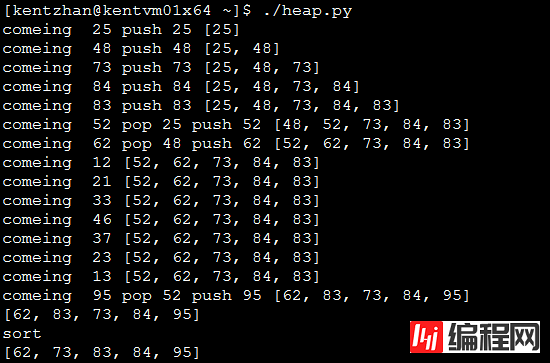Python 官方文档:入门教程 => 点击学习
heapq 模块提供了堆算法。heapq是一种子节点和父节点排序的树形数据结构。这个模块提供heap[k] <= heap[2*k+1] and heap[k] <= heap[2*k+2]。为
heapq 模块提供了堆算法。heapq是一种子节点和父节点排序的树形数据结构。这个模块提供heap[k] <= heap[2*k+1] and heap[k] <= heap[2*k+2]。为了比较不存在的元素被人为是无限大的。heap最小的元素总是[0]。
打印 heapq 类型
import math
import random
from cStringio import StringIO
def show_tree(tree, total_width=36, fill=' '):
output = StringIO()
last_row = -1
for i, n in enumerate(tree):
if i:
row = int(math.floor(math.log(i+1, 2)))
else:
row = 0
if row != last_row:
output.write('n')
columns = 2**row
col_width = int(math.floor((total_width * 1.0) / columns))
output.write(str(n).center(col_width, fill))
last_row = row
print output.getvalue()
print '-' * total_width
print
return
data = random.sample(range(1,8), 7)
print 'data: ', data
show_tree(data)
打印结果
data: [3, 2, 6, 5, 4, 7, 1]
3
2 6
5 4 7 1
-------------------------
heapq.heappush(heap, item)
push一个元素到heap里, 修改上面的代码
heap = []
data = random.sample(range(1,8), 7)
print 'data: ', data
for i in data:
print 'add %3D:' % i
heapq.heappush(heap, i)
show_tree(heap)
打印结果
data: [6, 1, 5, 4, 3, 7, 2]
add 6:
6
------------------------------------
add 1:
1
6
------------------------------------
add 5:
1
6 5
------------------------------------
add 4:
1
4 5
6
------------------------------------
add 3:
1
3 5
6 4
------------------------------------
add 7:
1
3 5
6 4 7
------------------------------------
add 2:
1
3 2
6 4 7 5
------------------------------------
根据结果可以了解,子节点的元素大于父节点元素。而兄弟节点则不会排序。
heapq.heapify(list)
将list类型转化为heap, 在线性时间内, 重新排列列表。
print 'data: ', data
heapq.heapify(data)
print 'data: ', data
show_tree(data)
打印结果
data: [2, 7, 4, 3, 6, 5, 1]
data: [1, 3, 2, 7, 6, 5, 4]
1
3 2
7 6 5 4
------------------------------------
heapq.heappop(heap)
删除并返回堆中最小的元素, 通过heapify() 和heappop()来排序。
data = random.sample(range(1, 8), 7)
print 'data: ', data
heapq.heapify(data)
show_tree(data)
heap = []
while data:
i = heapq.heappop(data)
print 'pop %3d:' % i
show_tree(data)
heap.append(i)
print 'heap: ', heap
打印结果
data: [4, 1, 3, 7, 5, 6, 2]
1
4 2
7 5 6 3
------------------------------------
pop 1:
2
4 3
7 5 6
------------------------------------
pop 2:
3
4 6
7 5
------------------------------------
pop 3:
4
5 6
7
------------------------------------
pop 4:
5
7 6
------------------------------------
pop 5:
6
7
------------------------------------
pop 6:
7
------------------------------------
pop 7:
------------------------------------
heap: [1, 2, 3, 4, 5, 6, 7]
可以看到已排好序的heap。
heapq.heapreplace(iterable, n)
删除现有元素并将其替换为一个新值。
data = random.sample(range(1, 8), 7)
print 'data: ', data
heapq.heapify(data)
show_tree(data)
for n in [8, 9, 10]:
smallest = heapq.heapreplace(data, n)
print 'replace %2d with %2d:' % (smallest, n)
show_tree(data)
打印结果
data: [7, 5, 4, 2, 6, 3, 1]
1
2 3
5 6 7 4
------------------------------------
replace 1 with 8:
2
5 3
8 6 7 4
------------------------------------
replace 2 with 9:
3
5 4
8 6 7 9
------------------------------------
replace 3 with 10:
4
5 7
8 6 10 9
------------------------------------
heapq.nlargest(n, iterable) 和 heapq.nsmallest(n, iterable)
返回列表中的n个最大值和最小值
data = range(1,6)
l = heapq.nlargest(3, data)
print l # [5, 4, 3]
s = heapq.nsmallest(3, data)
print s # [1, 2, 3]
PS:一个计算题
构建元素个数为 K=5 的最小堆代码实例:
#!/usr/bin/env python
# -*- encoding: utf-8 -*-
# Author: kentzhan
#
import heapq
import random
heap = []
heapq.heapify(heap)
for i in range(15):
item = random.randint(10, 100)
print "comeing ", item,
if len(heap) >= 5:
top_item = heap[0] # smallest in heap
if top_item < item: # min heap
top_item = heapq.heappop(heap)
print "pop", top_item,
heapq.heappush(heap, item)
print "push", item,
else:
heapq.heappush(heap, item)
print "push", item,
pass
print heap
pass
print heap
print "sort"
heap.sort()
print heap
结果:

--结束END--
本文标题: 详解Python中heapq模块的用法
本文链接: https://www.lsjlt.com/news/14631.html(转载时请注明来源链接)
有问题或投稿请发送至: 邮箱/279061341@qq.com QQ/279061341
下载Word文档到电脑,方便收藏和打印~
2024-03-01
2024-03-01
2024-03-01
2024-02-29
2024-02-29
2024-02-29
2024-02-29
2024-02-29
2024-02-29
2024-02-29
回答
回答
回答
回答
回答
回答
回答
回答
回答
回答
0